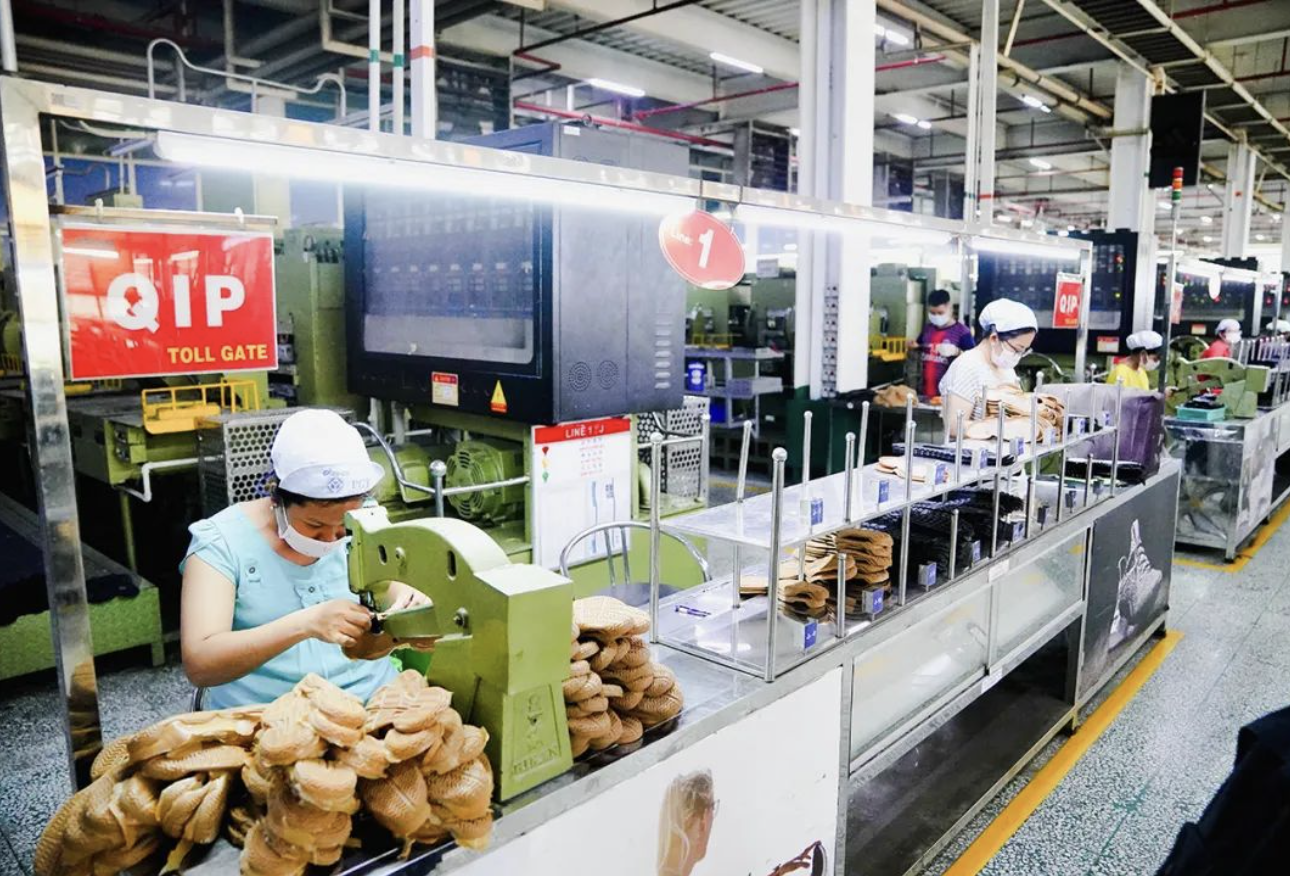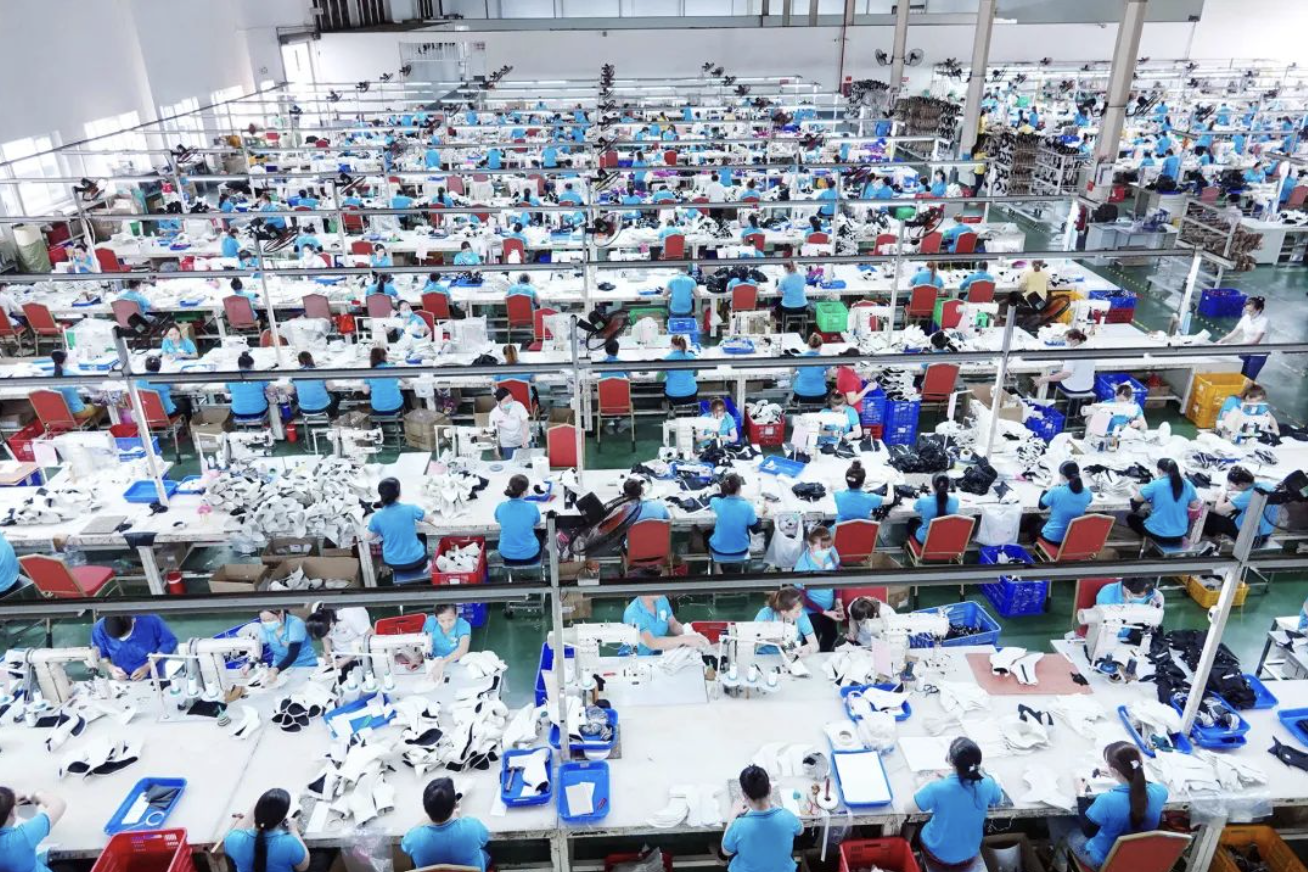The Vietnam Customs Department expects the country's footwear exports to exceed $20.24 billion by the end of 2023. Despite a decrease of $3.66 billion compared to the record high in 2022, footwear remains one of Vietnam's major export industries.
Looking back at history, Vietnam's footwear exports have continued to grow in recent years, except for 2020 due to the impact of the New Crown epidemic. Specifically, since 1998, footwear has been among the catalog of products with a turnover of more than 1 billion USD and constantly approaching 10 billion USD and 20 billion USD.
According to the World Leather and Footwear Yearbook 2021, in 2020, with more than 1.23 billion pairs of shoes, Vietnam for the first time accounted for more than 10 percent of the global footwear export market share, and ranked second in the world in the export of leather and footwear, only after China. As for cloth shoes, Vietnam is the world's largest producer by value, far more than China ...... At present, "Made in Vietnam" footwear products are available in 150 markets, including the US, the European Union, China, Japan, and the UK ... ...Among them, the US is the largest market, spending 7-10 billion USD annually on Vietnamese footwear.
The most obvious reflection of these figures is that some of the world's leading companies have chosen Vietnam as a production center for footwear to be sold globally. Specifically, two sneaker "giants", Adidas and Nike, have chosen Vietnam as a major production center in their global supply chains. Adidas 2020 report announced that up to 98% of production is concentrated in Asia, of which Vietnam accounts for 40%. Or Nike also announced that it produces about 600 million pairs of shoes annually, of which 50% are produced in Vietnam, and 50% of the materials in Nike's global supply chain also come from Vietnam.
At a sporting goods industry conference organized by the World Federation of the Sporting Goods Industry (WSGI) in cooperation with the Vietnamese Mission in Geneva in September 2023, Bertrand Tison, Head of Public for Europe at Decathlon, said that Vietnam is Decathlon's second-largest production facility in the world, with 130 partner factories and seven retail stores, 400 employees...
The Vietnam Leather and Footwear Industry Research Report 2022-2031, published in 2022 by Research and Markets, one of the world's leading market research firms, said that by the end of 2021, there were about 2,200 footwear manufacturing enterprises in Vietnam, mainly concentrated in the area around Ho Chi Minh City. Two global footwear giants, Nike and Adidas, have chosen Vietnam as their main production site, and a part of the global footwear industry chain has gradually moved from China to Vietnam because of the option of lower costs.
The main reason for Vietnam's footwear export boom is that Vietnam has signed trade agreements with Europe and the United States that favor exports. In particular, the Vietnam-EU Free Trade Agreement (EVFTA) has helped Vietnam's footwear products account for about 40 percent of exports to the EU. The Comprehensive and Progressive Trans-Pacific Partnership (CPTPP) has helped Vietnam's footwear exports to Canada and Mexico soar...

While Vietnam's footwear exports are making a name for themselves in the global market, in contrast, the domestic market is rather sluggish.More than 12 years ago, when Viễn Thịnh Footwear Company was just a small business with only a few dozen workers, it gradually entered the domestic market, with nearly 90 percent of its products coming from China.The director of the company said that in those days, he needed to go to the market personally to convince every vendor to sell the company's products at their stalls. to sell the company's products at their stalls. With quality, price, design, after-sales service and warranty, the company's footwear products gradually conquered the domestic market.
However, in recent years, the company could not compete with the low-priced products that appeared in abundance, so it only produced products for export. The chairman said that low-priced Chinese goods still account for more than 80 percent of Vietnam's market share; the rest are some foreign luxury brands and some domestic production factories. The main reason is that the price of goods produced in China is too low. Specifically, a pair of Chinese women's leather shoes only sells for around VND220,000-250,000 because the production cost is only VND150,000. Meanwhile, domestic enterprises cost about VND200,000-220,000 to produce a pair of leather shoes, which must be sold for VND350,000 to make a profit.
"The low price is mainly due to the large production volume, for example, they produce a Chinese shoe model sold in many countries with a production volume of up to 100,000 pairs, while the number of Vietnamese enterprises is only 2,000 pairs - 5,000 pairs if they produce a shoe.The same shoes still cost money to study the design, set of molds ...... China has formed a closed-loop area from raw materials to finished products, while Vietnam does not. Plus things like many types of fabrics and leather, which are not available in Vietnam domestically, must be imported by companies, so it is understandable that costs are higher." Viễn Thịnh's company director explained.
In addition, footwear products are fashionable items that need to be regularly replaced with new designs and styles. However, most Vietnamese businesses are very small, family companies ...... so they do not have enough resources to research and develop designs. Also unlike China, there are many policies to encourage and invest in the application of high technology such as robots in production to increase production capacity; Vietnamese small businesses do not have enough potential to invest in technology, machinery and equipment ......
Similar to the apparel industry, for footwear products to be known by consumers, companies need to build a brand while developing products with the right quality and price. However, branding stories of Vietnamese companies are extremely rare. A representative of a domestic footwear company admitted that many long-born Vietnamese footwear brands have now almost disappeared. Meanwhile, foreign companies with global brands and strong potential are expanding. On the contrary, domestic enterprises are small, with only a handful of units with more than 1,000-2,000 employees and low profit margins that fluctuate only around 5-6%, so there are not enough resources for larger investments. Enterprises are afraid to borrow from banks for investment because their profits are not enough to pay the interest on the loans. What's more, this industry is characterized by a 1-2 month off-season and a lack of orders ...... So Vietnam only focuses on paying wages to retain workers. As a result, Vietnamese footwear has almost lost its domestic market share.

Vice President of Vietnam Leather, Footwear and Bags Association said that the leather and footwear industry has created jobs for more than 1.5 million workers, occupies the second place in the world in exports and will continue to maintain this position, because the third-ranked country is Indonesia, but in terms of production, there is still a big gap with Vietnam. But Vietnam is far from the first China, the position there is still far. In other words, it is difficult to change the position of the first and second world footwear exports in the short term. Vietnam still has geopolitical advantages. Meanwhile, tariffs on Vietnamese footwear imports to a number of major markets, such as the United States, the European Union, Canada, etc., have fallen sharply when participating in a number of free trade agreements.
But it will also be difficult to have a clear breakthrough when the industry still has a series of long-standing problems that need to be changed. There is a need to develop supporting industries, apply technology and automation, meet new and increasingly demanding market requirements for origin, ensure environmental, social and environmental standards (ESG), green production ......
Currently, nearly 80% of Vietnam's footwear exports still belong to foreign-invested (FDI) companies. Therefore, it is most important to increase the value of Vietnamese footwear in export activities rather than promoting an increase in volume. To have higher-value products, there must be investment, increased technology application, research and design development, shifting to circular production, green production ...... To change these things and bring stronger growth to the footwear industry, Vietnamese footwear needs comprehensive policies, never just one company or a few individual policies.
Meanwhile, the deputy director of the Institute of Economics and Policy at Hanoi National University said that traditional industries such as textiles, garments and footwear have seen strong growth over the past 10 years. This is due to advantages such as Vietnam being considered an attractive destination for international investors in processing and manufacturing. Many large companies in the leather and footwear industries have integrated Vietnam into their global supply chains, increasing production in Vietnam, such as Nike and Adidas.
Also, Vietnam is an active participant in the new generation of free trade agreements in ASEAN. Since then, tariff barriers have also been reduced or eliminated, helping Vietnamese products become more competitive. The above factors have contributed to more new markets for Vietnamese-made products, expanding their share in the world market. Meanwhile, policies such as reforming the business environment, supporting domestic enterprises, promoting supporting industries, and applying high technology ...... have also helped promote purely Vietnamese enterprises to improve their ability to link and participate in global production chains.
However, consumer demand has declined and many changes have occurred since the New Crown epidemic. For example, popular products, which are Vietnam's strengths, have declined more; while demand for specialized and specific products has increased. Or the cost of production in Vietnam continues to increase while countries producing similar products still maintain lower input costs. Another issue is that Vietnam's slow transition to green production has also weakened the competitiveness of domestic products. These are all challenges for domestic enterprises.
"Vietnam's advantage of cheap labor is now almost no longer a major factor in being able to compete. Therefore, there is a need to increase technological innovation, improve governance, labor and connectivity. for greater participation in the supply chain and production of Vietnamese FDI companies." In Vietnam, some Vietnamese wholly-owned companies are also trying to rise, but there is still a need to focus on input factors such as raw materials, R&D, design and style, and the government could consider supporting the development of footwear supporting industries. The deputy director added: "The footwear industry needs to gradually reduce the amount of sourcing from China. Focus on linking domestic businesses with global manufacturing companies in Vietnam to facilitate trade, which can then be promoted abroad."
















